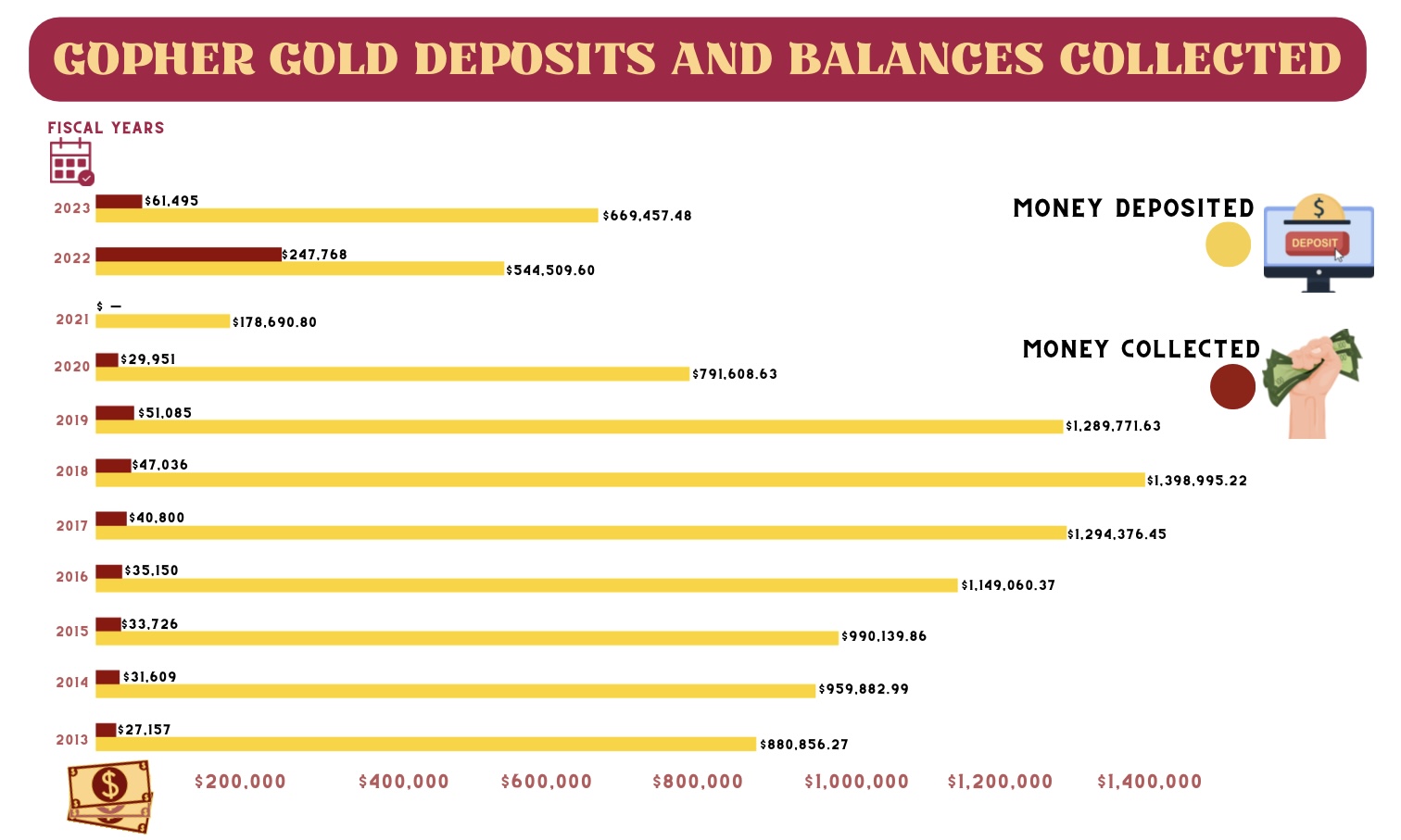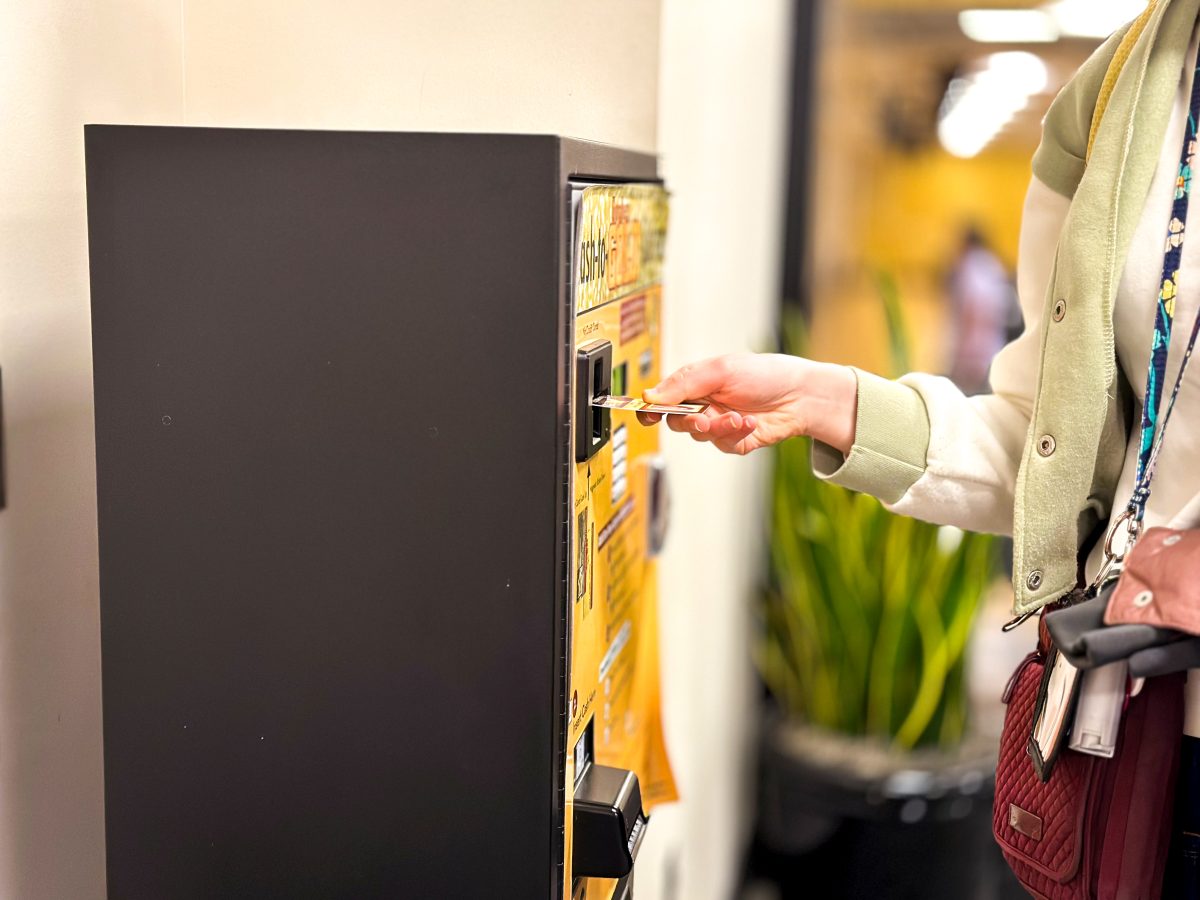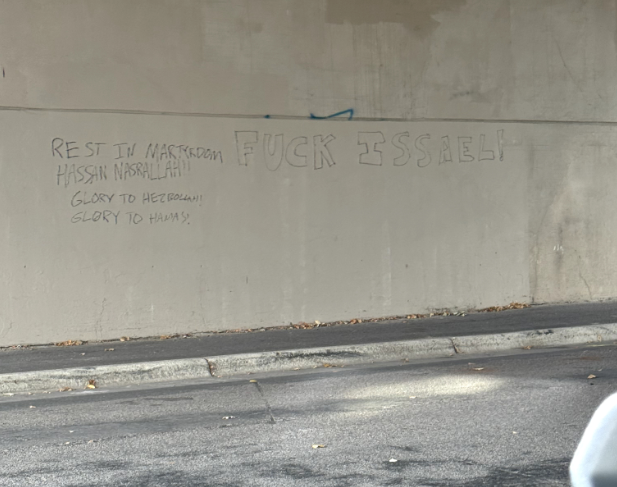The University of Minnesota collected over $1 million of funds in Gopher GOLD and Dining Dollars accounts in the last ten years.
About 30% of that total came from funds that expired in 2022 after the University allowed a pause in recapturing due to the COVID-19 pandemic.
Students, staff and faculty who deposit into these accounts agree to terms of use that funds will expire after a certain time. For Gopher GOLD, balances are forfeited after 12 months of inactivity and Dining Dollars expire each May.
The University recaptured just over $300,000 in Gopher GOLD in the last two years — about as much as it collected from 2013 to 2020 combined.
Students, faculty and staff deposited over $10 million into Gopher GOLD accounts in the last decade.
Despite taking in tens of thousands of dollars in forfeited funds yearly, as well as fees for depositing money online, the program is in the negative almost every year. The program is self-supporting but housed within the U Card Office budget and subsidized because it is “considered a common good service,” according to a post-interview email from Nick Mabee, a strategic communications and marketing manager with the University.
The recent surge in recaptured funds is not due to a similar rise in deposits or sales using Gopher GOLD. Sales and deposits in 2023 were both down about 50% from their respective amounts in 2019.
Just over half of the Gopher GOLD program’s revenue from the last decade has come from collecting inactivity fees and account balances, totaling at $605,000. If the program did not collect tens of thousands of dollars from students each year, its future might be unclear, Mabee said.
“We would need to go to the central funding office and see if we would be able to continue the program,” Mabee said.
Online deposits decreased by over 30% from 2019, and deposits at ValuPort locations and the U Card Office, which do not include deposit fees, declined by about one-third each.
Gopher GOLD account holders can only submit requests for account closure when they are no longer a student or employee. According to a follow-up email from Mabee, the policy is in place because closing and potentially having to reopen accounts would require an unsustainable amount of administrative time.
COVID-19 delayed recapturing of funds
In 2020, some students did not have the chance to return to campus and the University decided to extend students’ time to use their remaining Dining Dollars, said Amy Keran, director of contract administration. Over 17,000 students currently have Dining Dollars.
“We did it as a gesture of goodwill, just to allow students to roll over those funds,” Keran said.
The University collected no leftover Dining Dollars in 2023 due to “work disruption” in the fall of the previous year, Keran said.
Teamsters Local 320, which represents 1,500 service workers at the University, reached a deal with the University in October 2022, a week before the union was set to strike. The groups were in negotiations since June for the next contract agreement.
The University switched its food service management partnership from Aramark to Chartwells in April 2022.
Switching from Aramark as a dining vendor to Chartwells was a “massive change,” Keran said. Many full-time staff positions had to be filled as well as hiring new student employees.
“We couldn’t hire people fast enough,” Keran said.
After transitioning to the new vendor, the University elected not to have excess Dining Dollars rollover between academic years. Instead, any unused funds are recaptured each May.
Sales in dining halls and food retail locations shot back up faster than sales for vending machines, which now accept Gopher GOLD, credit cards and Apple Pay, Keran said.
Where does the money go?

Unspent Gopher GOLD goes toward supporting the program itself, such as with costs for software subscriptions that are necessary for the Gopher GOLD program to exist on campus.
The forfeited Dining Dollars are transferred to Housing and Residential Life and contribute to fund capital improvement projects, like a two-year renovation project for Middlebrook dining hall that will begin this summer, Keran said.
Though the funds go to these projects, the University does not budget for the revenue, Keran said.
“[The recaptured funds] help us in terms of what we can or cannot do,” Keran said. “We have a huge priority list.”
17th Avenue Hall was built in 2013 and the University is already planning for necessary renovations five years down the line because kitchen equipment does not last as long as it used to, Keran said.
Gopher GOLD allows students to pay less for services like printing as opposed to using a credit card to pay, which would add 2.3% of the transaction plus around $0.30 to each transaction. If a student wanted to print one page, the cost would be closer to half a dollar with those fees instead of the current $0.10 per page, Mabee said.
“It helps both the department and the students, as far as cost saving goes,” Mabee said.
Since students are encouraged to carry their U Card with them while on campus, it makes accessing Gopher GOLD convenient, Mabee said.
Almost 80% of Gopher GOLD users are undergraduate students, followed by 12% being graduate students and the remainder being faculty and staff.
Each online deposit to a Gopher GOLD account comes with a $2.50 web convenience fee, but withdrawing from an account costs four times that amount. If an account has less than $10 at the time of closing, the University receives the entire remaining balance, according to Mabee.
The difference in the fees is because they do not go to the same place, Mabee said. The deposit fee goes toward the online servers and the credit card processing fees that accompany each deposit. The closure fee goes toward the staff time for closing an account and the accounting processing to guarantee each student receives the correct amount of money.
Staff can deposit to Gopher GOLD through the payroll deduction program, which can take a set amount from a paycheck and instead deposit it into the Gopher GOLD account, Keran said.
“I like to use it because when I’m on campus, and if I’m at the bookstore, and I want to purchase something, I can do that,” Keran said.
Printing sales struggle to recover
Printing at libraries, print labs and College of Design specialty printing accounts for over 30% of all sales made with Gopher GOLD.
Paying with Gopher GOLD is the only way to print on campus, and implementing ways to pay directly with cash would mean higher labor costs, Keran said.
“Somebody would have to go and collect all the change, every day,” Keran said.
Printing sales remain 40% lower than their peak in 2019. Library and print lab sales have been slower to recover than design school specialty printing.
One factor in the decline was likely the University’s switch to the online learning management system Canvas, which allows students to access digital textbooks and submit papers online more easily than in the past, Mabee said.
A lot of revenue used to come from library Gopher GOLD patron cards, which visitors could use to print on campus. Now, the cards are not used much, if at all, Keran said.
“There’s just a decline in the need to print stuff on campus every day,” Mabee said.
Many of the print shops spread throughout campus have also closed and not reopened, Keran added.
Third-year Siya Sakhardande has used Gopher GOLD for printing since her first year at the University. She estimated she generally deposits less than $5 a semester.
When her account balance reaches under $1, Sakhardande said she puts the remainder toward printing for her classes.
“I just try to use it up as much as I can,” Sakhardande said.
Sakhardande said she made use of her apartment building’s free printing last year living at 44 North but has since moved out.
Using Gopher GOLD for printing is convenient, but Sakhardande said the minimum deposit amount of $10 is a downside.
“I can justify the cost, but I don’t like the minimum,” she said.
The University collected almost $250,000 in unused Gopher GOLD in 2022 following the pause in recapturing due to COVID-19.
In August and October 2022, Gopher GOLD sent emails to account holders with a notice that their balances would be forfeited by November.
Mabee said the most likely explanation for the massive surge is that account holders graduated and had not been checking their University emails.
The University announced late last year it would no longer offer umn.edu email accounts for graduates and retirees. The U Card Office is in the process of figuring out how to send messages to those who are no longer at the University, Mabee said.
Why the University gets the money
The University has the right to recapture unspent Gopher GOLD and Dining Dollars due to its terms of use. The Gopher GOLD terms of use stipulate any remaining balances after 12 months of account inactivity go to the University while all Dining Dollars must be used by the end of the academic year.
When someone deposits Gopher GOLD or Dining Dollars at the U Card office, they fill out a form acknowledging the terms and conditions. Online deposits also require the individual to say they have read the terms of use.
“We don’t budget those funds to come in for that reason, and we try and prevent them when we can,” Mabee said.
Generally, when a balance is sitting in an account, the organization or institution storing the account must hand the unclaimed money over to the state. In Minnesota, the law requires that funds be transferred to the Department of Commerce after three years of inactivity on the account.
Each state has its own unclaimed property laws, and Minnesota is in the middle in terms of what is considered unclaimed property and the waiting period for it to default to the state, according to Freda Pepper, president of the Unclaimed Property Professionals Organization.
Leaving unclaimed property in the state’s hands is better than with a company or university, Pepper said.
“They’re in a better position to hold it for the rightful owner to come and claim it,” Pepper said.
As a parent to three kids who went to three different colleges, Pepper said it is common for universities to require that students agree to the use-it-or-lose-it terms of use for credit accounts similar to Gopher GOLD.
“I remember having to play that game, and I always under-bought it and let them put more on when they need it,” Pepper said. “I didn’t want to find myself in that situation.”














Leif
May 8, 2024 at 1:30 pm
What a shady practice this is – & shameful. I’m surprised this hasn’t been addressed via policy at the State level.